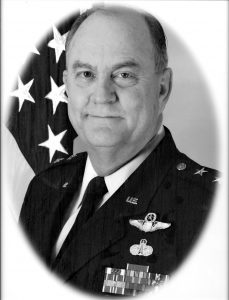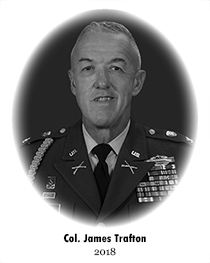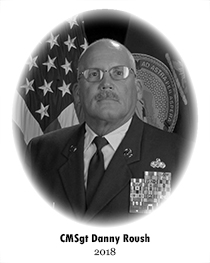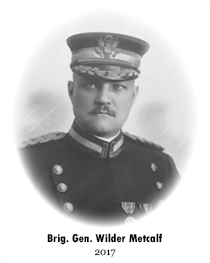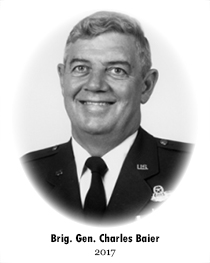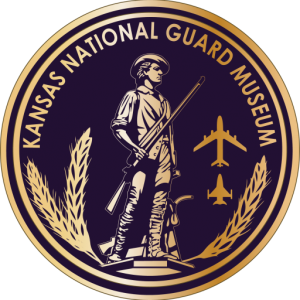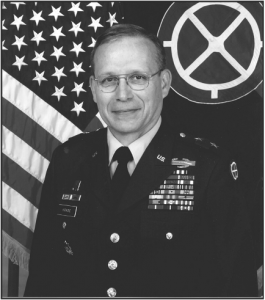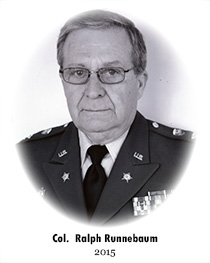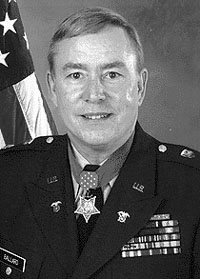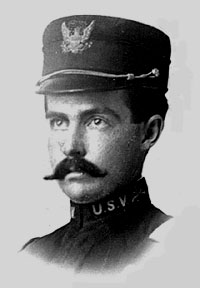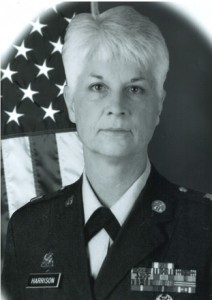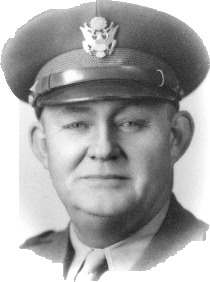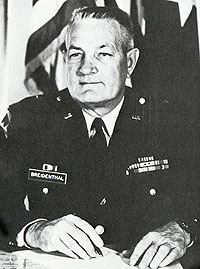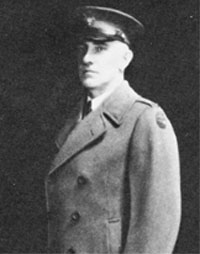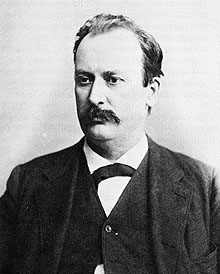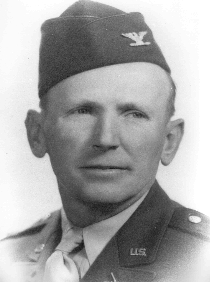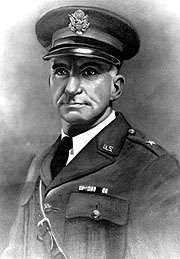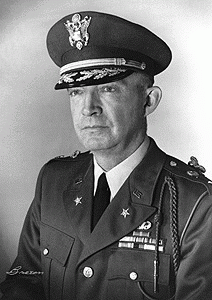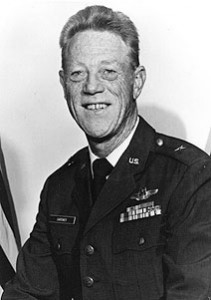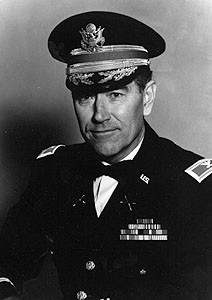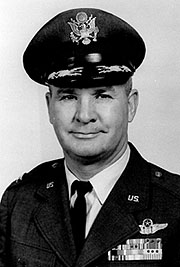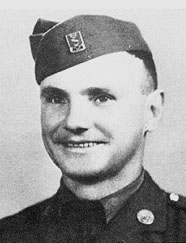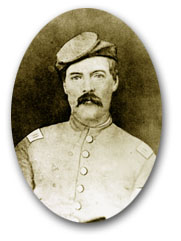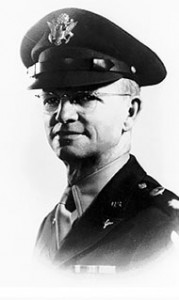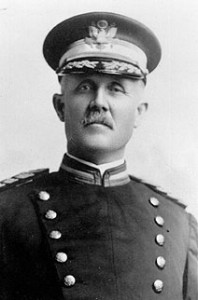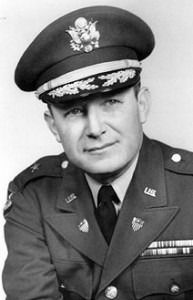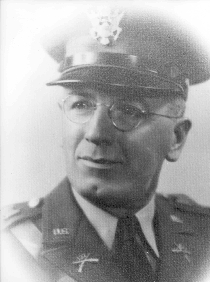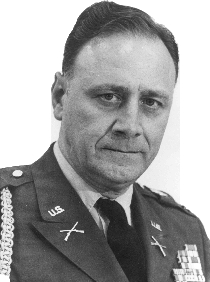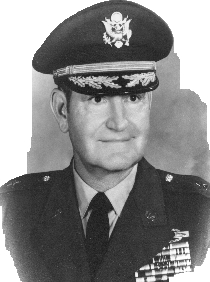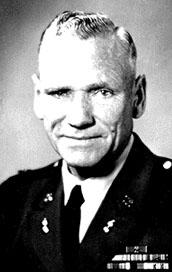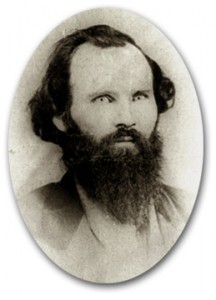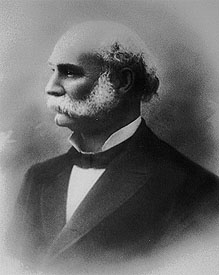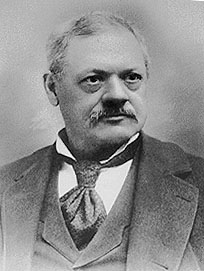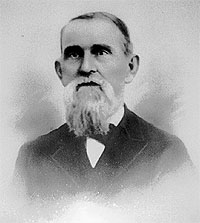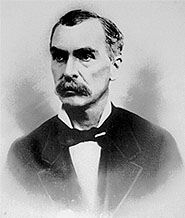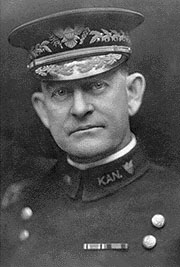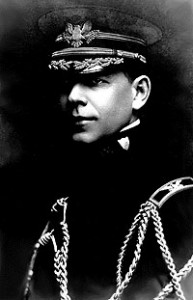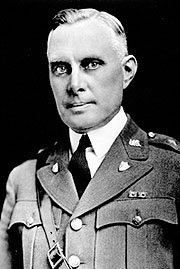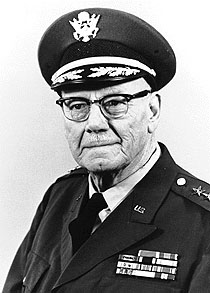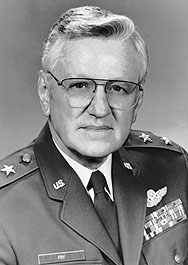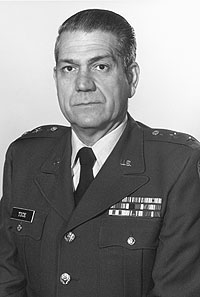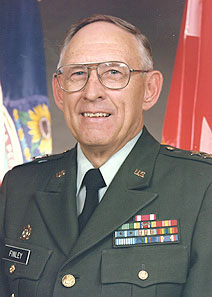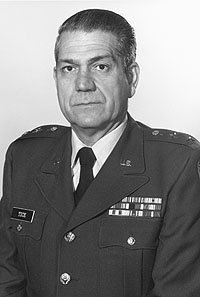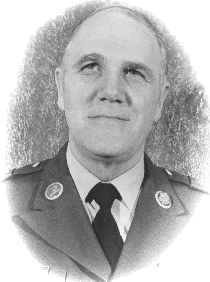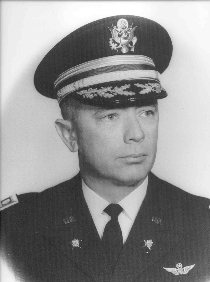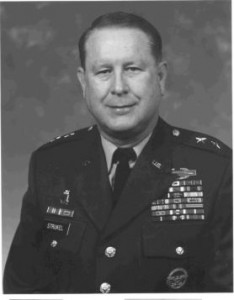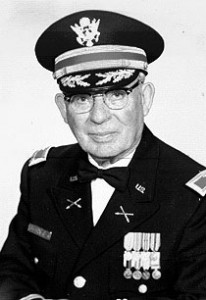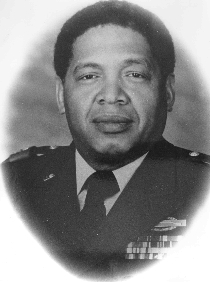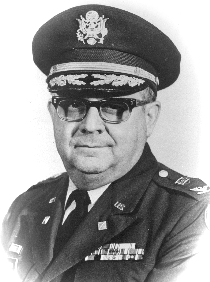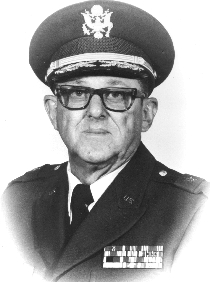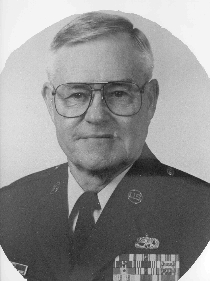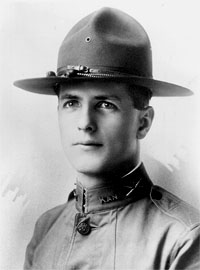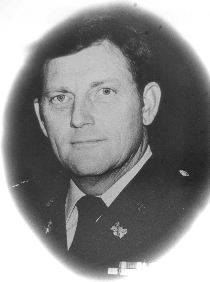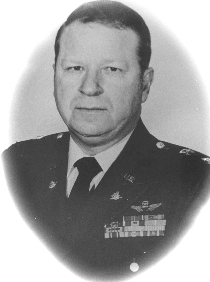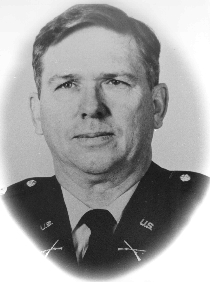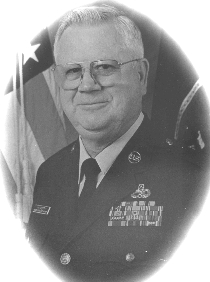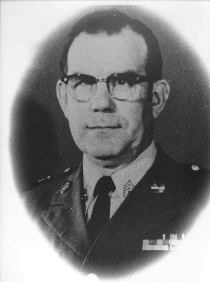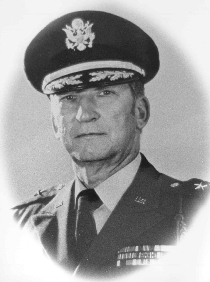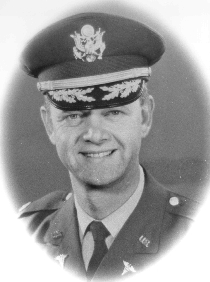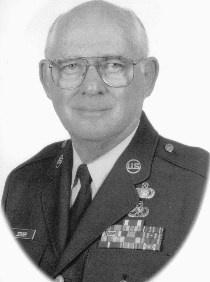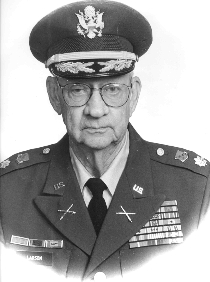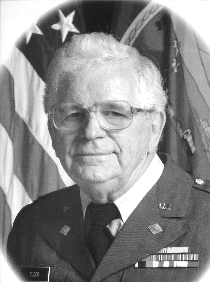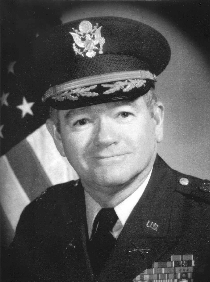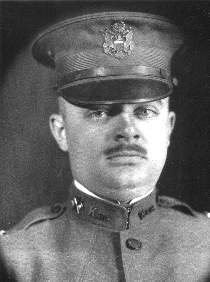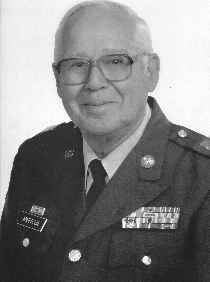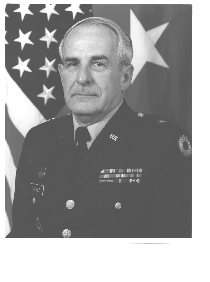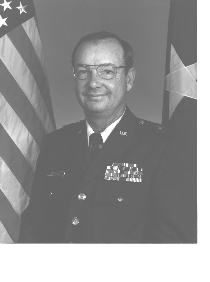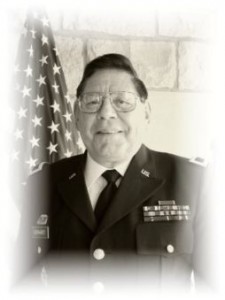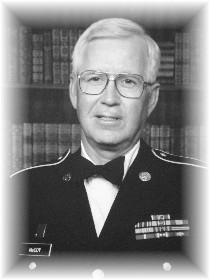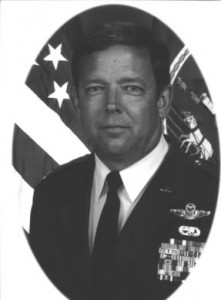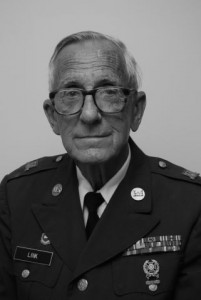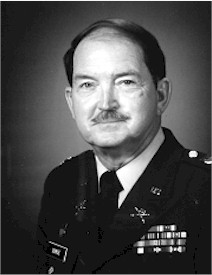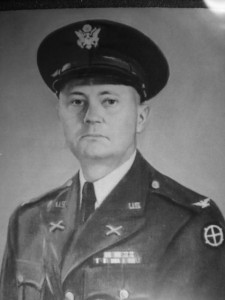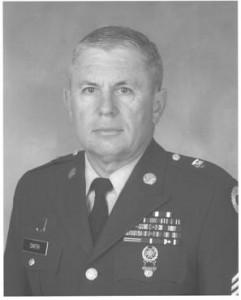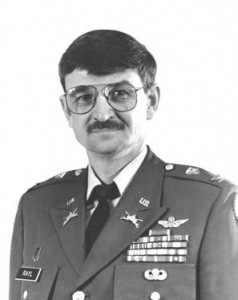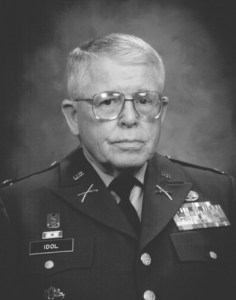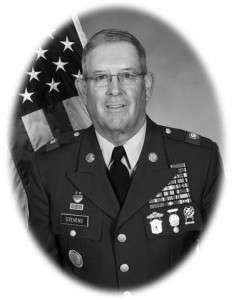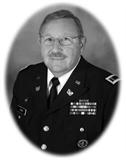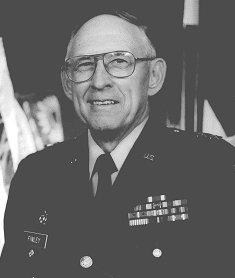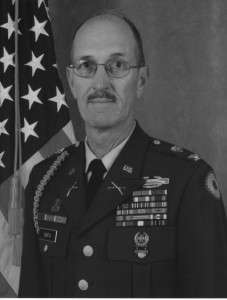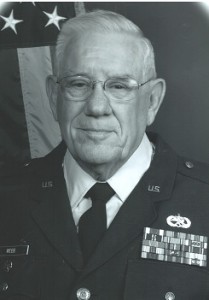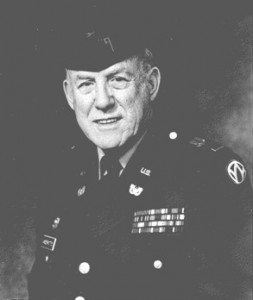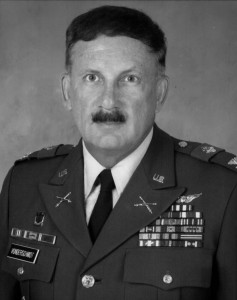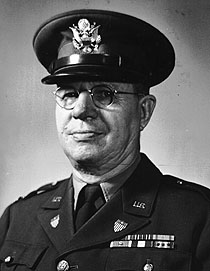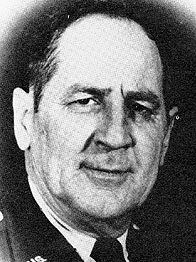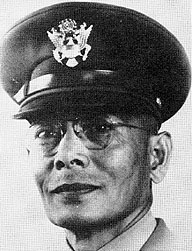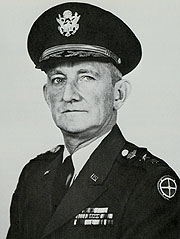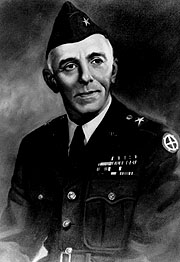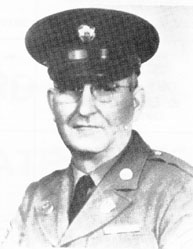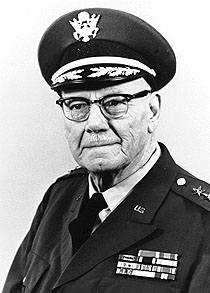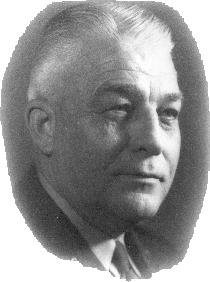The organization of this regiment was completed by consolidating “independent battalions” and squadrons and detachments originally intended for other organizations. The permanent organization was effected March 27th, 1862, in accordance with the following extract from General Orders from Headquarters State of Kansas.
[General Orders No. 1.]
(Extract.)
In accordance with the request of the major General commanding the Department of the Mississippi, the Kansas volunteer regiments will be consolidated and organized as follows:
The Ninth Regiment Cavalry will be organized as follows:
FIELD AND STAFF
Colonel – Edward Lynde
Lieutenant Colonel – C. S. Clarke
1st Major – E. P. Bancroft
2d Major – J. M. Pomery
Surgeon – H. C. Bostwick
Adjutant — ___________________
Quartermaster – A. G. Carpenter
The organization of D company, Eighth Regiment Kansas Volunteers, which afterward formed a part of the Ninth Cavalry in its permanent organization, was commenced September 13, 1861. The men were mustered in by detachments, and the organization of the company completed October 24th, 1861. At the final organization of the regiment this company was designated A company, with an aggregate of eighty-one men – Capt., George F. Earl; First Lieut., Joshua A. Pike; Second Lieut., Albert D. Earl.
The organization of H company, Eighth regiment Kansas volunteers, was commenced September 21st 1861. This company was also mustered into the United States service by detachments, and its organization completed on the 20th of November, 1861. At the completion of the regimental organization this company was designated B company, Ninth Kansas Volunteer Cavalry, with an aggregate of ninety men. Asaph Allen, of Lawrence, was mustered in as First Lieutenant of the company on the 12th of October, and on the 20th of November as Captain of said company. Lemuel T. Heritage, of Emporia, First Lieutenant vice Allen, and Robert Madden, of Emporia, Second Lieutenant.
The organization of I company, Third Regiment Kansas Volunteers, was completed July 24th, 1861, and regularly mustered into the United States service. At the time of the organization of the Ninth Regiment Kansas Volunteer Cavalry, March 27, 1862, this company was designated C company, with an aggregate of ninety-four men. John E. Stewart was mustered in as Captain July 24th, 1861, John Bowles as First Lieutenant, and W. J. Buchanan as Second Lieutenant, all of Lawrence.
The organization of D company, 1st Battalion Kansas Cavalry, was commenced October 19th, 1861, and the company organization completed January 16th, 1862, at which date the company was mustered into the United States service. The muster-out rolls of D company show Charles F. Coleman as having been mustered in as Captain on the 19th of October, 1861; Anderson C. Smith as First Lieutenant, and Avery T. Spencer as Second Lieutenant, all of Geneva, Kansas. This company, when merged into the Ninth Kansas Cavalry, consisted of eighty-three men.
E company was organized at the same date, as part of the same battalion, with Captain Henry Flesher, First Lieutenant Claudius M. Meek, and Second Lieutenant, Jesse Parsons, all of Iola, Allen county, Kansas. A majority of the enlisted men, sixty-eight in number, are from the same place.
The organization of F company was commenced Oct. 19th, 1861. This company was recruited for the purpose of protecting the citizens of the south and southwest frontier against the merciless savages and inhuman bushwhackers that were infesting that portion of Kansas. They had already sacked and robbed the town of Humboldt, and killed or carried away many of the best citizens and settlers in that vicinity. Enraged at the outrages already committed, and continually expecting a repetition of these crimes, the people rallied, old and young, for the protection of their homes. The company went into winter quarters at Iola, where it performed all the duties required of regular soldiers – scouting, picketing and patrolling the country for many miles around. They performed this duty throughout that long and cold winter, furnishing their own subsistence, munitions and accoutrements. They continued their outposts and scouting parties when so destitute of everything necessary for such service that those going on duty borrowed clothing, &c., from those in camp. Notwithstanding the difficulties and embarrassments in their way they continued the organization, and rendered most effective service in the protection of that portion of Kansas. January 16th, 1862, the company, numbering eighty-one men, was regularly mustered into the United States service, with Captain Benjamin F. Goss, First Lieutenant Isaac W. Dow, both of Neosho Falls, and Second Lieutenant Henry H. Opdyke, of Leroy. On the 27th of March, 1862, this company was designated F company, Ninth Regiment Kansas Volunteer Cavalry.
The organization of – company, 1st Battalion Kansas Cavalry, was commenced September 9th, 1861. The organization was completed January 16th, 1862, by the muster into the United States service of eighty-one enlisted men, with Captain Willoughby Doudna, muster to date December 17th, 1861; First Lieutenant Lewis C. Thompson, muster to date October 15th, 1861, and Second Lieutenant John N. Walkup, muster to date same as First Lieutenant Thompson. This company, at the time of consolidation, was designated G company, Ninth Kansas Volunteer Cavalry.
The organization of – company, 1st Battalion Kansas Cavalry, was commenced October 22d, 1861, and mustered into the United States service January 16th, 1862, with Captain Thomas P. Killen, muster to date January 2d, 1862; First Lieutenant James W. Christian, muster to date January 2d, 1862, and Second Lieutenant H. N. F. Reed same date. At the date of consolidation into the Ninth Kansas Volunteer Cavalry, the company numbered seventy-seven men, and was designated H. company. It was recruited in Neosho Valley.
The squadron designated company I in the organization of the Ninth Kansas Cavalry, was recruited in the fall of 1861 and the spring of 1862. First Lieutenant Mathew Cowley and a large portion of the men composing the company were mustered into service March 6th, 1862. Second Lieutenant Albert S. W. Knapper was mustered to date November 6th, 1861. The company numbered fifty-two men at the time of the regimental organization of the Ninth Cavalry. May 28th, 1862, the organization of the company was completed, and Horatio N. F. Reed, of Central City, mustered in as Captain.
K company was organized and mustered into the United States service July 11th, 1862 – Thomas M. Bowen Captain; J. D. Wells First Lieutenant, and Francis N. Sales Second Lieut. This company was mostly recruited in Marshall and Washington counties, Kansas.
Recruiting for L company commenced March 2d, 1863. On the 2d of May First Lieut. John I. Delashmutt and fifty-three men were mustered in. Second Lieutenant Charles C. Southard was mustered August 15th, 1863, and the company organization completed September 21st, by the muster- in of First Lieutenant James L. Arnold vice Delashmutt, promoted Captain.
The organization of M company was commenced June 11th, and completed August 21st, 1863 – Captain, Wm. W. P. McConnell; First Lieutenant, Stephen L. Kenyon, Second Lieutenant, John L. Price. This company was mostly recruited in the Neosho Valley.
At the time of the consolidation and organization of the detachments of the 1st Battalion Kansas Cavalry, of the third Kansas Volunteers, and of the Eighth Kansas Volunteers into the companies forming the first nine companies of the Ninth Kansas Cavalry, they were at Fort Leavenworth, Kansas. Soon after the organization of the regiment, in 1862, companies A, B, C, G, and I were detached by Special Orders No. 43 of Brig. Gen. James G. Blunt, dated Fort Leavenworth, Kansas, June 10th, 1862, and scattered from the Missouri River to the Rocky Mountains. Company B was stationed in the mountains, fifty miles north of Denver City, Colorado, and directed to build what was afterwards known as Fort Halleck. Company A was sent on escort duty to Fort Union, New Mexico. Company G was sent to Fort Lyon, Colorado. Company I was sent to Fort Larimie, and company C to Fort Riley, Kansas.
Four companies of the regiment – D, E, F and H – under the command of Major Bancroft, of the Ninth, participated in the fight known as the “Locust Grove Affair,” in the Cherokee Nation. This was among the first engagements in which any of the regiment participated. The result though not of very great significance, reflected credit on the troops engaged – marching all night, surprising the enemy at break of day, capturing over forty prisoners, together with all their camp and garrison equipage — thus giving an earnest of what might be expected of them. The same portion of the regiment, under Colonel Lynde, in the month of August, 1862, were engaged in the running fight and skirmish with the rebel General Coffey, which continued for eight consecutive days and nights, during which time the troops were kept in their saddles, dismounting only long enough to feed themselves and horses. In this affair their endurance was more fully tested than their courage.
In the fall of ’62 the regiment (except for those companies out on the Plains) under General Solomon, marched to Sarcoxie, Mo., thus confronting the rebel command under Generals Cooper and Rains. In this position, it was a foregone conclusion that an engagement of some kind must ensue, and the Ninth was destined to be the chief actors in bringing it on. About the last of September Colonel Lynde was ordered to make a reconnaissance of the enemy’s position and force at or near Newtonia. This was done, and the following day an engagement took place, in which the Ninth played an honorable and conspicuous part, although its conduct was by a few aspersed, prompted to it by malice or jealousy.
Early in the morning Lieut. Colonel Jacobbi, of the 9th Wisconsin, with a part of that regiment and two guns of the 2d Ohio Battery, began the attack. At 9 o’clock Colonel Lynde appeared on the field and took command bringing with him four squadrons of his own regiment, together with a section of mountain howitzers attached to the regiment. Disposing of this limited force to the best advantage, the attack was pressed with all of the energy and courage possible. The enemy fought obstinately, fortified behind stone walls, in a large stone barn, and in several brick houses, till, despite this advantage in position, and their large superiority in numbers, they were gradually being dislodged and driven, when a vidette came in announcing a heavy rebel column rapidly approaching from the direction of Granby. This being a dangerous flank movement, and the rebels already greatly outnumbering our force, a hasty retreat was the only course left. To do this and save the infantry and artillery, was the no light task demanded of the cavalry, especially as the retreat had to be conducted over a mile and a half of prairie. By repeated charges and the most stubborn resistance on either flank, the rebels were so far checked as to enable all of the artillery and a portion of the infantry to escape. All that cavalry could do was done and that their valor was felt by the enemy the number of their slain will attest. Added to the discouraging features of this fight should be the fact, that these companies of the Ninth Kansas were without carbines and but poorly armed with revolvers. Their ranks were decimated; they fought until they were literally crowded from the field, finally gathering all that could be saved from a defeat.
Four days after this the rebels were driven from Newtonia southward, the Union troops pressing them gradually toward the Arkansas river. During the time intervening between the Newtonia affair and the fights of Cane Hill and Prairie Grove, the regiment was actively engaged in escorting paymasters to Fort Scott and supply trains back to the army, together with the responsible duties of scouting and feeling of the enemy in the immediate front. The accuracy of its reports and the fidelity with which it accomplished its scouting missions, frequently elicited the public and private approval of the General commanding. In the Cane Hill fight but two companies of the Ninth took any part.
During the night preceding the battle of Prairie Grove the Ninth, along with the balance of the cavalry, were put in position near Cane Hill, and were awaiting the approach of the enemy, when it was discovered that they were maneuvering for a more advantageous battle field, and were pressing our left flank. A countermarch was immediately ordered, and the cavalry fell back to Rhea’s Mills where the supply and ammunition train was corralled.
General Herron with his command having come up, encountered the enemy on the Fayetteville road, and opened the engagement at once. General Blunt, hearing the cannonading, moved to the scene of action with all of his infantry and artillery, leaving the cavalry in charge of the wagon train and supplies. One company of the Ninth (D) had, during the morning, been engaged with the enemy’s advance guard, and during the battle occupied an advanced position and rendered efficient service in hovering and fighting on the enemy’s flanks.
During the night succeeding the fight Colonel Lynde was ordered to convey the train of wagons loaded with ammunition and quartermaster stores to Fayetteville.
One day’s fight convinced the rebel General Hindman that his most prudent and wise policy was to place as much distance between his army and the Union army as possible, and thus terminated the battle of Prairie Grove.
While the cavalry cannot demand for itself the same meed of glory that justly belongs to the other two arms of the service, it may, without immodesty, claim a share. It did what soldiers are expected to do: it obeyed orders.
In the raid on Van Buren the Ninth took an active part. It was in the rear of General Blunt’s command, and was among the first to enter the town, having successfully driven a rebel force which had been resisting its advance. To it was also confided the trust of clearing the town of stragglers and bringing up the rear of the column when the army returned to Rhea’s Mills. This raid may be considered as the closing aggressive movement of the Army of the Frontier.
Colonel Lynde, with his regiment, in February, 1863, was ordered to Fort Scott as a convoy to an immense supply train, accompanying which were a great number of refugee wagons. It is no idle responsibility to safely conduct a train several miles in length through a hostile and dangerous country. It requires indefatigable care, energy and watchfulness. Of the many hundred thousand dollars’ worth of army stores and provisions, which have been entrusted to the protection of this regiment, not one dollar’s worth has been captured or wrenched from it by guerrilla band or rebel force.
The frequent and desperate raids made by the bushwhackers of Western Missouri on the border counties of Kansas, rendered it necessary that troops should be stationed along the borders so as to guard against the recurrence of such depredations. Accordingly the Ninth was assigned to this field of operation in March, 1863. Among the first encounters with the bushwhackers may be mentioned the sanguinary skirmish one mile south of Westport, on the 17th of June, 1863.
General Thos. Ewing had just taken command of the District of the Border, and being informed that the guerillas under Todd and Parker intended a raid on Kansas City, he ordered to the latter place Major L. K. Thatcher, with three companies of the Ninth. This officer was in command at Paola, from which station he marched to Aubrey, taking with him A company of the Ninth. At the latter place he added to his command a part of K company, under Captain Pike, the balance being out on a scout with E company, under Captain Flesher. Sending orders for Captain Flesher to join him at Kansas City, with his own company and all that he had of K company, Major Thacher moved on to Kansas City, where he reported to General Ewing, who ordered his command into camp, which was hardly accomplished when a courier announced that the guerrillas had ambushed and routed the force under Captain Flesher en route for Kansas City. General Ewing immediately ordered Major Thacher with his command back to the assistance of Captain Flesher. Passing through Westport, and southward a half mile, he met wagons bringing in the dead, victims of the fight. From citizens along with these wagons, the particulars of the ambuscade and the direction taken by the bushwhackers after the fight was ascertained. The most intense darkness had by this time set in, and it became necessary to advance cautiously. Reaching the scene of the disaster, several of the soldiers who had been dismounted in the fight, and had escaped in the woods, came to the command, from whom it was made certain that a part of the guerrillas, bend on booty, and taken a southward course down the state line; the balance had retreated towards the hills of the Sniabar. Hoping to overtake the band which had gone down the state line, the troops pursued in that direction., striking the guerrilla trail the next morning near Indian Creek, and promptly following it through a devious course into the dense woods and underbrush along ravines, until finally the enemy was discovered in camp, reposng after their terrible fatigue. A charge was immediately made. A number of the guerrillas were killed, and all their horses, equipments and arms were captured, together with all they had captured in the fight on the previous day, thus inflicting on them a loss, though not equal to ours, still one which they severely felt.
The ambuscade of Captain Flesher’s command was of such a nature to wholly exculpate that officer, whose reputation for vigilance, sagacity and courage was beyond question in his own regiment, were he was best known. Marching but a few hours behind Major Thacher, and having approached to within less than a mile of a military station, a concealed enemy was little suspected, still the location and surroundings were of the most favorable character for a surprise – a stone fence on either side of the road, along which was thick underbrush and foliage. Behind these stone walls in the woods lay the bushwhackers awaiting the approach of the Union soldiers, and as soon as they came within range of their guns, like a thunderclap from a cloudless sky, came a volley of bullets from a quarter least looked for. A portion of the guerrillas remained mounted were so concealed as to be ready to follow up the first volley with a charge, which gave Captain Flesher no time to form his command or rally from the shock. Hedged in on both sides by stone walls, it was not until he had fallen back a half mile, and had experienced his greatest loss, that he was able to get his men in had, so as to make a successful resistance. Up to this time it was a hand to hand fight, each soldier being compelled to act on his own responsibility, but having passed beyond the stone walls to the first open space, Captain Flesher rallied his men and in turn repulsed the guerrillas, killing and wounding a number. His command behaved with the utmost coolness, and recovering from their temporary confusion, they disputed the ground as well as the place would admit. One of the guerrillas in this skirmish afterwards remarked that he “never saw better fighting than that which was done by Captain Flesher and some of his men.”
This affair gave the ninth a foretaste of the ferocity of the foe they had to deal with. The appeals of our wounded were only met by an additional bullet. All of our dead were found to have been shot through the head and heart, thus exhibiting the fiendish and atrocious character of these bushwhackers.
During the summer the regiment was stationed at different points along the border. Colonel Lynde, with headquarters, most of the time at Trading Post; Lieut. Colonel Clarke, with E & G companies, at Harrisonville; Capt. Pike, with K company, at Aubrey; Capt. Coleman, with D company, at Pleasant Hill, and Major Thacher, with A and H, at Westport.
From these several stations the detachments operated against the guerrillas; in fact, the whole summer was consumed in almost continual skirmishing. Capt. Coleman, with D company, had repeated encounters with them, in which he habitually proved himself an overmatch for them, either in sagacity, bravery or daring. Capt. Coleman had no superior in this kind of service, and the service no more efficient officer in finding, routing and killing bushwhackers. He could “beat them at their own game.” This company killed at least one bushwhacker for every man in the company.
Company C returned and joined the regiment at Trading post, Linn county, Kansas, in the month of _______. This company, under command of Lieut. Philbrick, at Cabin Creek, July 2d, 1863, participated in the engagement against General Cooper, who, with 2,200 men, met a government train taking supplies to the destitute command of Colonel Phillips at Fort Gibson, C.N., and made a most formidable resistance to the passage of the Federal troops at Cabin Creek. The 1st Regiment Kansas colored troops waded the stream chin deep, and after gaining a position on the south bank, engaged and routed the enemy, when company C charged into and through the rebel line, inflicting severe loss upon the enemy, and then holding them in check until the infantry again rushed upon them and compelled them to break in confusion and seek safety in flight, when C company continued the work of routing, killing and capturing the enemy until they had inflicted a loss upon him equal to the entire number of the company, with a loss of only two killed and a few wounded.
The Quantrell raid on Lawrence took place in the month of August, and nearly every squadron of the 9th participated in his pursuit. Capt. Coleman, with D company, and Capt. Pike, with K company, were the first on his trail. They struck his rear guard, as he was retreating southward from Lawrence, near Brooklyn, and hung on his rear and flank, fighting him until his band had scattered among the forests and their haunts in Missouri. Lieut. Col. Clarke, with E, G and F companies, encountered them as they passed the state line into Missouri, and did such execution as the nature of the retreat would admit. Major Thacher, with A and L companies of the 9th, and one squadron of the 11th Kansas, marched from Westport, and joined in the pursuit near Grand River. His command killed several of the raiders and recaptured some of the property plundered from Lawrence.
The fiends who perpetrated this atrocious massacre, although seeming to have every accident in their favor, and profiting by an unheard of audacity, still did not escape unpunished. From the time they left Lawrence until they finally found safety in their forest fastnesses, our troops attacked them at every opportunity, so that in the aggregate a large number of them were made to “bite the dust.” Never were soldiers summoned to fight a more bloodthirsty or cruel foe. No quarters were expected on either side. “No prisoners!” was the war cry by both parties, a policy inaugurated by the guerrilla leaders, and, as a sequence, no prisoners were taken either to Federal or rebel headquarters.
This service, from the spring of 1863 to the close of the war, in this part of Missouri, was of the most inhuman and barbarous character ever known to a civilized people. The soldiers constituting the large armies were indeed fortunate in comparison with the 9th and other troops detailed on this fearful duty of fighting bushwhackers. Were the former killed in battle and left in the hands of the enemy, an honorable burial and unmutilated body was at least awarded them; were they wounded, medical aid and some care was bestowed on them, and if, unhappily, they were captured, the prospect of an exchange of prisoners was ever before them. Contrast this treatment with the unfortunate fate of the Union soldiers on the border. In the hands of the guerrillas, if killed, their poor, inanimate bodies were outraged and disfigured; if wounded, their pain and misery was augmented by such torture as malignant ingenuity could devise; and if, perchance, by some strange freak of generosity, or through mistake, they were made prisoners, it proved only an additional calamity, for after undergoing brutal insults, they were invariably butchered in such manner as the dark and savage caprice of their captors might suggest. One more chapter terminates the record of this regiment on the border, and this was their participation in the expulsion of Shelby and his raiders from Missouri.
Several weeks after the Lawrence massacre, Quantrell collected his bands of bushwhackers and moved out of the state in a southwest course towards Texas. About the same time General Ewing received word that the rebel General Shelby had entered the state from the south and was moving towards his district, committing devastation and threatening to enter Kansas; whereupon he mustered all the available troops under his control and hovered along the eastern line of his district, anticipating the movements of the invaders. Meanwhile, General Brown, commanding the district east of General Ewing’s, had, with the troops under him, engaged the rebels near Marshall and successfully repulsed them, cutting their force in two, so that in their retreat one portion of the rebels moved off in the direction of Tipton, while the main command, under Shelby and Coffey, retreated toward Warrensburg and the District of the Border. General Ewing, with his troops, struck their trail about four hours after they had passed a point not far southwest of Warrensburg. Pressing his cavalry furiously along, together with two sections of mountain howitzers, the rebel rear guard was encountered just at evening, posted on a hill skirted with timber and dense underbrush. The 9th Kansas, under Lieut. Col. Clarke and Major Thacher, were ordered forward and directed to dislodge them from their position. Dismounting and advancing on foot, they drove the rebels from their first position and again charged them in their second; but so effectually were they concealed, that our men had advanced to within close range, and had received their first volley, before they were fully aware of their proximity. But without hesitation they rushed forward with an impetuosity that swept the rebels from their stronghold. No more resistance was met until the command reached Carthage. Before arriving there, however, Colonel Lynde, with several companies of the 9th Kansas, joined General Ewing’s force. This officer had been ordered to guard the southeastern border of Kansas, so that a sudden incursion could not be made in that direction without some dispute. The invaders having passed the point of danger, Colonel Lynde marched rapidly to Reub’s Point, where he awaited the arrival of the Federal troops. General Ewing’s command approached Carthage at daybreak, where the rebels had camped and were trying to rally their wasting strength. Captain Earle, with A company of the 9th, led the charge into the town, capturing their outposts and subsequently a large number of prisoners. Shelby, with his jaded crew made but a faint resistance, but continued his rapid retreat. The pursuit was not relaxed until near Neosho, when it was deemed imprudent and useless to follow further with the main command. Major Thacher, with Captain Earle and forty men of A company, were, however, ordered to follow and open up communications with General McNeil, who, it was supposed, was pressing down from the Springfield district. This small force of the 9th pursued the retreating rebels out of Missouri into Arkansas, over one hundred and fifty miles south of Neosho, encountering numerous bands of guerrillas, vanquishing all opposition, until they found the rebels had crossed the Boston Mountains, when they returned, overtaking General Ewing’s command at Fort Scott.
The 9th Kanss, in this exhausting chase, were severely tried. For twenty-six days, and a large portion of every night, were they in the saddle, ready to march, forage or fight. The men could endure more than their horses. Many of the cavalrymen walked more miles than they rode, so as to husband the strength of the animals on which they so implicitly relied in the hour of need.
The regiment, by detachments, returned to their several stations, where they remained until March, 1864, when by a Special Order from General Schofield, all Kansas troops in Western Missouri were ordered over the line into Kansas. Previous to this, however, Colonel Lynde, wishing to get his regiment together and to be connected with a larger army, and engaged in a warfare where the foe had at least some honor, instead of the brutal and unnatural service of hunting and fighting bushwhackers, (a feeling to which the entire regiment responded,) had made application to the War Department to have his regiment sent either to the Cumberland or to General Steele, then preparing to cooperate with General Banks in his Red River Expedition. To the latter Department the regiment was assigned, and accordingly in March they rendezvoused at Lawrence, preparatory to joining that army.
Since the organization of the regiment, at no one time before had it been assembled together, so that for both officers and men there was a reasonable assurance that in the future their efforts would be consolidated, and that they should act as one body with one purpose. The regiment numbered 1,200 men at this time.
On the 3d of April the regiment began its march for Little Rock, Arkansas, via Harrisonville, Clinton and Springfield. From the latter place southward their route led them through a country scoured by both armies, destitute of meat and of nearly everything which horses or mules could eat. A small supply of corn was taken from Springfield, but utterly insufficient to meet the wants of a command traversing a region of three hundred miles, mountainous and barren, save here and there a small flat made at the confluence of mountain streams. Every day foraging parties were sent out to glean whatever of roughness or grain might have escaped the rapacity of preceding troops. But despite the most untiring industry and sagacity, the horses and mules became nearly famished, daily growing thin and weak, until finally many were unable to go farther and were left on the road to shift for themselves or to die. During one night the mules ate off seventeen wagon tongues to which they had been tied, so keenly were they pinched with hunger. And to add to the distress of the regiment, it became water bound at a place on Kings River, and was detained there two days.
At Springfield Colonel Lynde received orders to report at Fort Smith instead of Little Rock, the original destination. Having crossed the Boston Mountains and the Arkansas river at Ozark, the regiment marched to Fort Smith, on the south side thereof. Arriving there, orders were found directing the regiment to report at once at Little Rock, and without halting long enough to rest or recruit, it recrossed the river at Van Buren, passed down the north side as far as Clarksville, when it was again met with imperative orders from General Steele to return to Fort Smith by forced marches as that place was in imminent danger. Lieut. Colonel Clarke, picking the most able of men and horses, promptly complied with the order, halting en route only long enough to feed the animals, accomplishing the distance of one hundred and fifty miles in fifty-four hours. At Van Buren nothing but a flat but a flat boat was at hand to ferry the command over; and as delay was dangerous, Colonel Clarke ordered the saddles and equipments to be transferred in a boat and the horses to be driven in and forced to swim across, which was successfully accomplished without casualty, and the command enabled to report without much delay to the commanding officer at Fort Smith. The enemy threatening the Fort having declined an attack, the regiment was ordered into camp on Hazzard Prairie, where it remained until July.
F company was stationed at Van Buren May 23d, but did some very efficient and successful service in scouting and patrolling the country. On the 25th of June Lieut. I. W. Dow, with but four men, chased and killed the rebel Col. Faith, of an Arkansas regiment, and captured his horse and accoutrements when within rifle range of his command, and escaped without loss. June 30th, Lieut. Opdyke, with a small foraging party, was attacked at midnight by a force double their own number, and despite the confusion of the midnight attack, they successfully repulsed them, with a loss of one sergeant killed and one corporal wounded.
During our stay here Colonel Lynde was in command of the Cavalry Brigade, and the regiment did the most arduous duty, scouting and skirmishing. Major Doudna, with four companies, made a scout and foraging expedition on the north side of the river, gathering a large amount of corn for the Fort, capturing a number of prisoners, and killing eight or ten of the enemy, among whom was a rebel Lieut. Col., bearing dispatches of importance to the guerrillas operating in Northern Arkansas and Missouri.
Lieut. Col. Clarke, with five companies of the 9th and four of the 6th Kansas, was ordered to penetrate southward as far as Dallas, to ascertain the intention and force of the enemy. Near Quito he encountered a rebel command which he vigorously charged, putting them to flight, capturing twenty or thirty prisoners, from whom he obtained the desired information, and then returned to camp, having accomplished the object of his scout. Another important raid was made by Major Thacher, with four companies of the 9th, four of the 6th, three of the 14th Kansas, and three of the 4th Arkansas Infantry, to a locality known as Lane’s Bottom, down the river about one hundred miles below Fort Smith. The march most of the distance was accomplished during the night time, so as to effect a surprise of a rebel force reported camped at that place. A deserter having carried information ahead, this part of the programme failed. Nevertheless the expedition accomplished all that was expected of it. It had several skirmishes with the rebels, killing twelve, among whom was a Major Pitsworth, a wealthy rebel of this locality, who had been very vindictive and abusive to all the Union men of this region.
July 2d the regiment took up its line of march for Little Rock once again, where it arrived July 14th, and went into camp on the north side of the river. Here the men suffered intensely from impure water and excessive heat, but there was no respite from active duty for them
The repulse of General Banks, and consequently of Steele, afforded the rebels the opportunity of detaching large bands of cavalry to harass and destroy the communications to Little Rock. Among the more enterprising of the rebel Generals assigned to this service were Shelby, Marmaduke and Fagan. Against the troops of each of these leaders the 9th was often pitted.
Majors Pomeroy and Doudna made an expedition towards White River, in which expedition they did good service, routing and dispersing the rebels operating in that section, and this gave some security to the small posts acting as defense to the railroad running from Duvall’s Bluff to Little Rock.
In August, from information derived from scouts, it was known that rebel conscripting parties were scouring the country between the railroad and the Arkansas river, impressing all who were able to bear arms. General Steele ordered a detachment of soldiers from the 9th Kansas, under Major Thacher, to proceed to the vicinity of Clear Lake, and liberate that region from the presence of the conscriptors. By a rapid movement this command was enabled to completely surprise their chief rendezvous, routing Col. Lightfoot’s command, taking some prisoners, destroying a large amount of commissary stores, and effectually defeating the conscripting movement in that section.
In the meantime the rebel General Shelby had succeeded in passing north of the Little Rock railroad, and had for a long time baffled all efforts to dislodge him from his strongholds on White River, from which, with fearful rapidity, he would dart down on the railroad when and where he was least expected, commit immense damage and then retreat as suddenly as he came. An expedition was fitted out, (of which the 9th was a part), under Lieutenant Colonel Clarke, and ordered to pursue him after one of these characteristic raids, in which he had destroyed a large amount of hay and haying implements, had captured nearly a whole regiment of infantry and burned their quarters.
Following swiftly after them, Col. Clarke’s command struck Shelby’s rear guard north of Brownsville, and immediately began to press them. A running fight was kept up until they reached Bull Bayou, where the rebels made a stand. Availing themselves of the strong position afforded by the stream and surroundings, they made a desperate attempt to effectually resist any further advance of the Federal troops. Two battalions of the 9th were dismounted and ordered to make the charge, Maj. Pomeroy leading one, and Maj. Thacher the other. The former received the first and most fatal volley, but without faltering, it rushed across the stream and up the bank, pouring a steady fire into the enemy, who soon broke and fled. The other battalion, crossing the bridge, and charging impetuously on the left, were equally triumphant. The Union loss was very heavy, and the rebel loss still larger. The pursuit was kept up for twenty miles, until Shelby’s force was so effectually scattered and punished as to insure thereafter safety and security to the communications between Duvall’s Bluff and Little Rock.
When Price crossed the Arkansas river en route for his famous raid into Missouri, the 9th was sent to annoy and act as a corps of observation, Price keeping his command so consolidated as to leave no opportunity to attack him in detail.
In September Capt. Coleman made a brilliant scout south of Little Rock, in which he achieved a victory over a rebel command three times his number. Shortly after, Lieut. Dow, of F company, also made a scout south from Little Rock, in which he and his command won distinction. They fought a rebel force largely their superior in numbers, which had ambushed them, and after a short but sharp encounter put them to flight, leaving thirty of their men dead on the field. This may be said to wind up the active and important service of the regiment. There are a vast number of heroic deeds of officers and privates, which must necessarily go down to future generations along with the endless unwritten history of the war.
Owing to the fact that the companies composing the regiment were, soon after the regimental organization, so widely scattered, and on account of the nature and character of the duty they were called upon to perform, it is impossible to give in detail an account of each battle and skirmish in which each part was engaged. It is unquestionably true, however, that the duty they were called on to perform was of the most dangerous and arduous kind, and required the most vigilant care and sound judgement on the part of each officer and man. Had the regiment, been from its organization, kept together and assigned a place where distinction was awarded for valiant and faithful service, it would, undoubtedly have carved out for itself a record which would have added still additional luster to the already enviable fame which justly belongs to it, as well as to the other heroic regiments sent forth by the State of Kansas.
(SOURCE: Report of the Adjutant General of the State of Kansas, 1861-’65. Topeka, Kansas: 1896 reprint. Transcription provided by Erma Payne, Civil War Round Table of Eastern Kansas.)

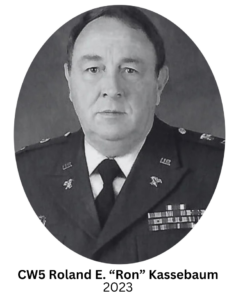 CW5 Roland E. “Ron” Kassebaum was born on February 21, 1946 in Deshler, Nebraska. He graduated from Hebron High School, Hebron, Nebraska in 1964. He attended Fairbury Junior College, Fairbury, Nebraska and the University of Nebraska, Lincoln, Nebraska, and received a Bachelor of Science Degree from the University of the State of New York in 1991. He later attended Liberty University, Lynchberg, Virginia, for courses in accounting and Allen County Community College, Iola, Kansas, for a course in Business Law.
CW5 Roland E. “Ron” Kassebaum was born on February 21, 1946 in Deshler, Nebraska. He graduated from Hebron High School, Hebron, Nebraska in 1964. He attended Fairbury Junior College, Fairbury, Nebraska and the University of Nebraska, Lincoln, Nebraska, and received a Bachelor of Science Degree from the University of the State of New York in 1991. He later attended Liberty University, Lynchberg, Virginia, for courses in accounting and Allen County Community College, Iola, Kansas, for a course in Business Law.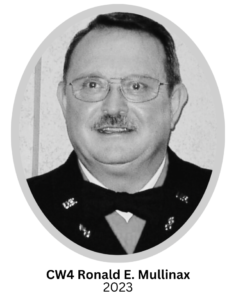 Chief Warrant Officer Four Ronald E. Mullinax was born on August 25, 1946, in Norton, Kansas to Earl and Mary Posson. He was adopted by John and Ada Mullinax. He grew up in Lenora, Kansas, graduating from Lenora Rural High School in 1965. After completing a Denver Automotive Institute training program, Ron worked at Look Body Shop in Norton until 1968.
Chief Warrant Officer Four Ronald E. Mullinax was born on August 25, 1946, in Norton, Kansas to Earl and Mary Posson. He was adopted by John and Ada Mullinax. He grew up in Lenora, Kansas, graduating from Lenora Rural High School in 1965. After completing a Denver Automotive Institute training program, Ron worked at Look Body Shop in Norton until 1968.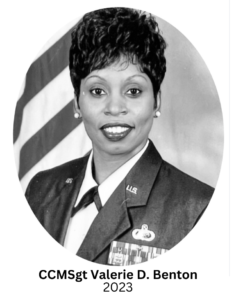 CCMSgt Valerie D. Benton was born on Dec. 10, 1959 in Racine, Wisconsin, where she spent her childhood. She graduated from Washington Park High School in 1978. Soon after graduation she enlisted in the U. S. Air Force and headed to Basic Training at Lackland AFB, Texas in December of 1978. After completion of Basic training, she attended Technical Training at Lowry AFB, Colorado, and graduated as a Food Service Specialist.
CCMSgt Valerie D. Benton was born on Dec. 10, 1959 in Racine, Wisconsin, where she spent her childhood. She graduated from Washington Park High School in 1978. Soon after graduation she enlisted in the U. S. Air Force and headed to Basic Training at Lackland AFB, Texas in December of 1978. After completion of Basic training, she attended Technical Training at Lowry AFB, Colorado, and graduated as a Food Service Specialist.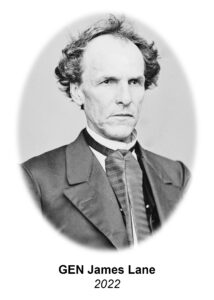 General James H. Lane was a militia leader during the Bleeding Kansas period, the commander of the Kansas “Jayhawker” Brigade during the Civil War, and was one of the first United States Senators from Kansas.
General James H. Lane was a militia leader during the Bleeding Kansas period, the commander of the Kansas “Jayhawker” Brigade during the Civil War, and was one of the first United States Senators from Kansas.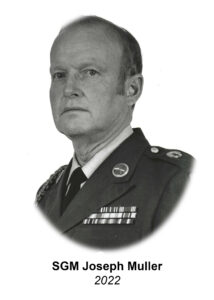 Sergeant Major Joseph T. “Jody” Muller was selected for the Kansas National Guard Hall of Fame for his exceptional service as a citizen soldier in the Kansas National Guard for over 41 years.
Sergeant Major Joseph T. “Jody” Muller was selected for the Kansas National Guard Hall of Fame for his exceptional service as a citizen soldier in the Kansas National Guard for over 41 years.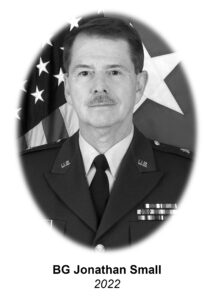 Brigadier General Jonathan P. Small served as The Adjutant General of Kansas from November 1, 2003 to January 4, 2004, culminating a 35-year military career as a distinguished attorney, community leader, citizen-soldier, and military leader. He served as Assistant Adjutant General-Army from 1999 to 2003, and as Commander of the Land Component for the Joint Force Headquarters-Kansas.
Brigadier General Jonathan P. Small served as The Adjutant General of Kansas from November 1, 2003 to January 4, 2004, culminating a 35-year military career as a distinguished attorney, community leader, citizen-soldier, and military leader. He served as Assistant Adjutant General-Army from 1999 to 2003, and as Commander of the Land Component for the Joint Force Headquarters-Kansas.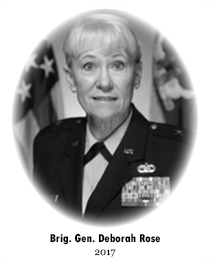 Brigadier General Deborah Rose entered military service with a direct commission into the United States Air Force Nurse Corps in March 1983, assigned to the 184th Tactical Fighter Group. She transferred to the 190th Clinic in December 1985. In October 1990, she deployed to Jeddah, Saudi Arabia, where she served in an Air Transportable Hospital during Desert Shield. In February 1991, she was activated and deployed to Offutt AFB, Nebraska, assigned to the hospital.
Brigadier General Deborah Rose entered military service with a direct commission into the United States Air Force Nurse Corps in March 1983, assigned to the 184th Tactical Fighter Group. She transferred to the 190th Clinic in December 1985. In October 1990, she deployed to Jeddah, Saudi Arabia, where she served in an Air Transportable Hospital during Desert Shield. In February 1991, she was activated and deployed to Offutt AFB, Nebraska, assigned to the hospital.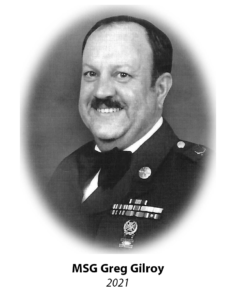 Master Sergeant Greg Gilroy was born on July 25, 1947 at Ottawa, Kansas. He was a lifelong resident of Ottawa, graduating from Ottawa High School in 1965. He then attended Emporia State University during the 1965-66 school year.
Master Sergeant Greg Gilroy was born on July 25, 1947 at Ottawa, Kansas. He was a lifelong resident of Ottawa, graduating from Ottawa High School in 1965. He then attended Emporia State University during the 1965-66 school year.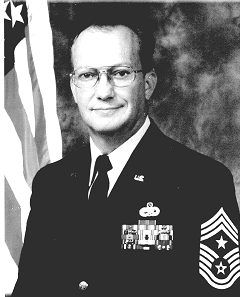
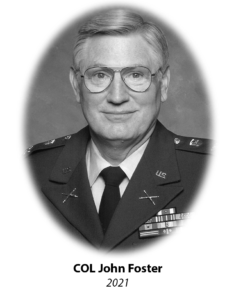
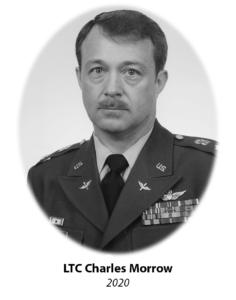
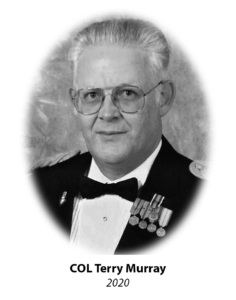

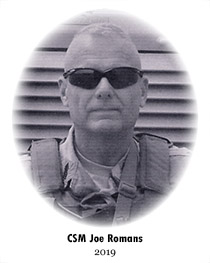
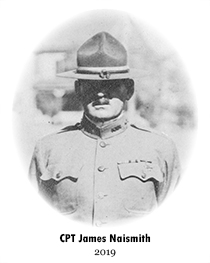

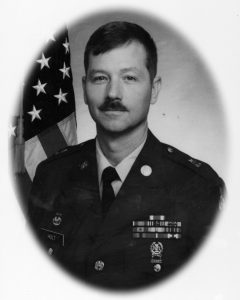 Sergeant Major Lynn E. Holt built his distinguished Kansas Army National Guard career developing strength, retaining Soldiers and insuring Soldiers received proper training. He served from the Detachment through State level. He is known for his ability to recognize Soldier needs at all levels. The same care he felt for Soldiers carried over into his community activities. SGM Holt’s passion for people and their needs exemplifies his true character. He devoted his entire adult life to the betterment of our nation, our state and the Kansas National Guard.
Sergeant Major Lynn E. Holt built his distinguished Kansas Army National Guard career developing strength, retaining Soldiers and insuring Soldiers received proper training. He served from the Detachment through State level. He is known for his ability to recognize Soldier needs at all levels. The same care he felt for Soldiers carried over into his community activities. SGM Holt’s passion for people and their needs exemplifies his true character. He devoted his entire adult life to the betterment of our nation, our state and the Kansas National Guard.